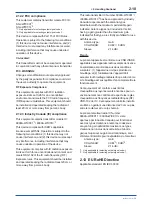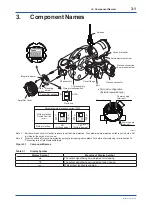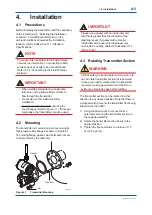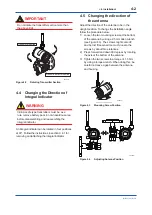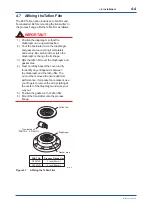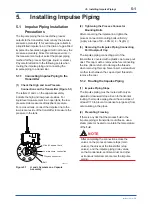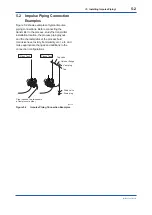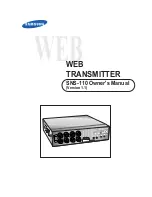
<2. Handling Cautions>
2-2
IM 01C27C01-01EN
2.3 Storage
The following precautions must be observed when
storing the instrument, especially for a long period.
(a) Select a storage area which meets the following
conditions:
• It is not exposed to rain or subject to water
seepage/leaks.
• Vibration and shock are kept to a minimum.
• It has an ambient temperature and relative
humidity within the following ranges.
Ambient temperature:
–40 to 85°C
–30 to 80°C LCD visible range
Relative humidity:
0% to 100% R.H.
Preferred temperature and humidity:
approx. 25°C and 65% R.H.
(b) When storing the transmitter, repack it carefully in
the packaging that it was originally shipped with.
(c) If the transmitter has been used, thoroughly
clean the chambers inside the cover flanges, so
that there is no process fluid remaining inside.
Before placing it in storage, also make sure that
the pressure-detector is securely connected to
the transmitter section.
(d) Preferably remove the batteries for storage. For
maximum battery life, the storage temperature
should not exceed 30°C.
NOTE
When storing the instrument with a battery
pack, it is recommended to put the instrument in
Deep Sleep mode to conserve the batteries. For
details on how to switch to Deep Sleep mode,
refer to subsection 8.3.13 “Switching to Deep
Sleep Mode”.
2.4 Selecting the Installation
Location
The transmitter is designed to withstand severe
environmental conditions. However, to ensure
that it will provide years of stable and accurate
performance, take the following precautions when
selecting the installation location.
(a) Wireless Communication
NOTE
The installation location of this transmitter must
meet the following conditions:
- Adjust the direction of the antenna to be
in the upright position regardless of the
orientation of this transmitter. See section 4
for adjusting the antenna.
- Install the transmitter at least 1.5m above
the ground or floor.
F0203.ai
at least
1.5m
- Ensure that there are no obstacles such as
walls or pipes within a 30-cm radius of each
antenna.
- Confirm that each field wireless equipment
compliant with ISA100.11a can see the
antenna of other devices which locate within
its own communication range. In the star
topology network, the visibility to the antenna
of gateway is a mandatory clause.



















